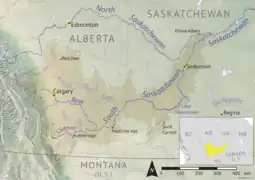Oldman River
The Oldman River is a river in southern Alberta, Canada. It flows roughly west to east from the Rocky Mountains, through the communities of Fort Macleod, Lethbridge, and on to Grassy Lake, where it joins the Bow River to form the South Saskatchewan River, which eventually drains into the Hudson Bay.
| Oldman River | |
|---|---|
 Oldman River seen from Veterans Memorial Highway | |
 The South Saskatchewan River drainage basin | |
 The mouth in Alberta  Oldman River (Canada) | |
| Location | |
| Country | Canada |
| Province | Alberta |
| Physical characteristics | |
| Source | |
| • location | Canadian Rockies |
| • coordinates | 50°06′50″N 114°43′14″W |
| • elevation | 2,100 m (6,900 ft) |
| Mouth | |
• location | South Saskatchewan River |
• coordinates | 49°55′45″N 111°41′27.4″W |
• elevation | 701 m (2,300 ft) |
| Length | 363 km (226 mi) |
| Basin size | 26,700 km2 (10,300 sq mi)[1] |
| Discharge | |
| • average | 95 m3/s (3,400 cu ft/s).[1] |
Oldman River has a total length of 362 kilometres (225 mi) and a drainage area of 26,700 km2 (10,300 sq mi).[1]
History
The Oldman River was, at one time, known as the Belly River.[2] The Belly River is now a separate river that is a tributary of the Oldman.
In 1991, the Alberta government finished construction of the Oldman River Dam. The Piikani renegade, led by Milton Born With A Tooth, had attempted to divert the Oldman River away from the Lethbridge Northern Irrigation District canal intake, leading to an armed standoff.[3] The dam was constructed where the Oldman, Crowsnest, and Castle river systems converge.
2013 floods
On June 21, 2013, during the 2013 Alberta floods Alberta experienced heavy rainfall that triggered catastrophic flooding throughout much of the southern half of the province along the Bow, Elbow, Highwood and Oldman rivers and tributaries. A dozen municipalities in Southern Alberta declared local states of emergency on June 21 as water levels rose and numerous communities were placed under evacuation orders.[4]
Tributaries

From headwaters to mouth, Oldman River receives:
- Livingstone River
- Crowsnest River
- Castle River
- Pincher Creek
- Beaver Creek
- Willow Creek
- Belly River
- Waterton River
- St. Mary River
- Lee Creek
- Little Bow River
Nature
Oldman River originates in the Beehive Natural Area,[5] an area of alpine tundra and old-growth spruce and fir forests. Downstream it flows through Bob Creek Wildland Provincial Park[6] and Black Creek Heritage Rangeland.[7] Oldman Dam and Oldman River are other Provincial Recreation Areas established along the river.
The river and some of its tributaries have formed coulees in Southern Alberta, and the strata revealed by these formations guide local prospectors to ammolite deposits.
Fish
The Oldman River contains fish species such as rainbow trout, cutthroat trout, bull trout, brown trout, hybrid trout species ("cutbow" rainbow and cutthroat cross), mountain whitefish, pike, walleye, lake sturgeon, catostomidae, goldeye, and minnows.[8]
References
- Atlas of Canada. "Rivers in Canada". Retrieved January 13, 2007.
- "McCord Museum - Keys to History". Retrieved September 11, 2020.
- University of Lethbridge. "Oldman River Dam". Archived from the original on September 24, 2013. Retrieved November 10, 2006.
- Kaufmann, Bill (June 21, 2013). "Thousands flee rising waters from Red Deer to Crowsnest". Calgary Sun. p. 3.
- Alberta Community Development. "Beehive Natural Area". Archived from the original on August 13, 2004. Retrieved November 12, 2006.
- Alberta Community Development. "Bob Creek Wildland Park". Archived from the original on March 10, 2007. Retrieved November 12, 2006.
- Alberta Community Development. "Black Creek Heritage Rangeland". Archived from the original on August 13, 2004. Retrieved November 12, 2007.
- "AlbertaFishingGuide.com: The Dependable Online Resource For Fishing In Alberta". AlbertaFishingGuide.com. Retrieved February 3, 2020.
External links
- Oldman Watershed Council: www.oldmanwatershed.ca